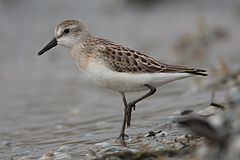- Wader
-
This article is about a group of birds. For the waterproof hip boots or fishing trousers, see Waders (footwear).
Waders 
Semipalmated Sandpiper (Calidris pusilla) Scientific classification Kingdom: Animalia Phylum: Chordata Class: Aves Order: Charadriiformes (partim) Suborders - Charadrii
- Chionidi
- Scolopaci
- Thinocori
Waders, called shorebirds in North America (where "wader" is used to refer to long-legged wading birds such as storks and herons), are members of the order Charadriiformes, excluding the more marine web-footed seabird groups. The latter are the skuas (Stercorariidae), gulls (Laridae), terns (Sternidae), skimmers (Rynchopidae), and auks (Alcidae). Also, the pratincoles (Glareolidae) and the Crab Plover (Dromadidae), which bear greater resemblance to waders, are closely related to the seabirds.
This leaves about 210[verification needed] species, most of which are associated with wetland or coastal environments. Many species of Arctic and temperate regions are strongly migratory, but tropical birds are often resident, or move only in response to rainfall patterns. Some of the Arctic species, such Little Stint are amongst the longest distance migrants, spending the non-breeding season in the southern hemisphere.
The majority of species eat small invertebrates picked out of mud or exposed soil. Different lengths of bills enable different species to feed in the same habitat, particularly on the coast, without direct competition for food. Many waders have sensitive nerve endings at the end of their bills which enable them to detect prey items hidden in mud or soft soil. Some larger species, particularly those adapted to drier habitats will take larger prey including insects and small reptiles.
Many of the smaller species found in coastal habitats, particularly but not exclusively the calidrids, are often named as "sandpipers", but this term does not have a strict meaning, since the Upland Sandpiper is a grassland species.
The smallest member of this group is the Least Sandpiper, small adults of which can weigh as little as 15.5 grams and measure just over 13 cm (5 inches). The largest species is believed to be the Far Eastern Curlew, at about 63 cm (25 inches) and 860 grams (1.9 lb), although the Beach Thick-knee, is the heaviest at about 1 kg (2.2 lb).
In the Sibley-Ahlquist taxonomy, waders and many other groups are subsumed into a greatly enlarged Ciconiiformes order. However, the classification of the Charadriiformes is one of the weakest points of the Sibley-Ahlquist taxonomy, as DNA-DNA hybridization has turned out to be incapable of properly resolving the interrelationships of the group. Formerly, the waders were united in a single suborder Charadrii, but this has turned out to be a "wastebasket taxon", uniting no less than four charadriiform lineages in a paraphyletic assemblage. However, it indicated that the Plains Wanderer actually belonged into one of them. Following recent studies (Ericson et al., 2003; Paton et al., 2003; Thomas et al., 2004a, b; van Tuinen et al., 2004; Paton & Baker, 2006), the waders may be more accurately subdivided as follows:
- Suborder Scolopaci
- Family Scolopacidae: snipe, sandpipers, phalaropes, and allies
- Suborder Thinocori
- Family Rostratulidae: painted snipe
- Family Jacanidae: jacanas
- Family Thinocoridae: seedsnipe
- Family Pedionomidae: Plains Wanderer
- Suborder Chionidi
- Family Burhinidae: thick-knees
- Family Chionididae: sheathbills
- Family Pluvianellidae: Magellanic Plover
- Suborder Charadrii
- Family Ibidorhynchidae: Ibisbill
- Family Recurvirostridae: avocets and stilts
- Family Haematopodidae: oystercatchers
- Family Charadriidae: plovers and lapwings
In keeping more in line with the traditional grouping, the Thinocori could be included in the Scolopaci, and the Chionidi in the Charadrii. However, the increasing knowledge about the early evolutionary history of modern birds suggests that the assumption of Paton et al. (2003) and Thomas et al. (2004b) of 4 distinct "wader" lineages (= suborders) already being present around the K-T boundary is correct.
See also
References
- Ericson, P. G. P.; Envall, I.; Irestedt, M. & Norman, J. A. (2003): Inter-familial relationships of the shorebirds (Aves: Charadriiformes) based on nuclear DNA sequence data. BMC Evol. Biol. 3: 16. doi:10.1186/1471-2148-3-16 PDF fulltext
- Paton, Tara A. & Baker, Allan J. (2006): Sequences from 14 mitochondrial genes provide a well-supported phylogeny of the Charadriiform birds congruent with the nuclear RAG-1 tree. Molecular Phylogenetics and Evolution 39(3): 657–667. doi:10.1016/j.ympev.2006.01.011 (HTML abstract)
- Paton, T. A.; Baker, A. J.; Groth, J. G. & Barrowclough, G. F. (2003): RAG-1 sequences resolve phylogenetic relationships within charadriiform birds. Molecular Phylogenetics and Evolution 29: 268-278. doi:10.1016/S1055-7903(03)00098-8 (HTML abstract)
- Thomas, Gavin H.; Wills, Matthew A. & Székely, Tamás (2004a): Phylogeny of shorebirds, gulls, and alcids (Aves: Charadrii) from the cytochrome-b gene: parsimony, Bayesian inference, minimum evolution, and quartet puzzling. Molecular Phylogenetics and Evolution 30(3): 516-526. doi:10.1016/S1055-7903(03)00222-7 (HTML abstract)
- Thomas, Gavin H.; Wills, Matthew A. & Székely, Tamás (2004b): A supertree approach to shorebird phylogeny. BMC Evol. Biol. 4: 28. doi:10.1186/1471-2148-4-28 PDF fulltext Supplementary Material
- van Tuinen, Marcel; Waterhouse, David & Dyke, Gareth J. (2004): Avian molecular systematics on the rebound: a fresh look at modern shorebird phylogenetic relationships. Journal of Avian Biology 35(3): 191-194. PDF fulltext
Categories:- Charadrii
- Chionidi
- Thinocori
- Shorebirds
Wikimedia Foundation. 2010.

